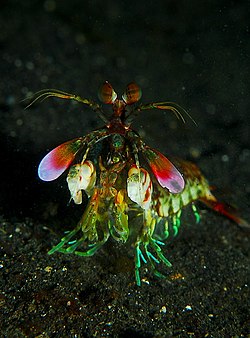Mantis shrimp
Mantis shrimps are crustacean stomatopods.
| Mantis shrimp | |
|---|---|

| |
| Scientific classification | |
| Kingdom: | |
| Phylum: | |
| Subphylum: | |
| Class: | |
| Subclass: | |
| Order: | Stomatopoda Latreille, 1817
|

They are not actually shrimps, but members of the order Stomatopoda. There are about 400 species.
They are predators which kill their prey by hitting them at high speed.
They hold their body in a manner like that of a praying mantis, and have large, complex eyes. Some species can be 30 cm long.
They are highly coloured, and live in shallow tropical and subtropical habitats such as coral reefs.
Attack methods
changeEach species has one of these two methods of attack
- Spearers are armed with spiny appendages topped with barbed tips, used to stab and snag prey.
- Smashers, on the other hand, have a club as an appendage, and a simpler spear. The spear is quite sharp and used in fights between their own kind. The club is used to bludgeon and smash their prey.
Both types strike by rapidly unfolding and swinging their claws at the prey, and can cause serious damage on victims larger than themselves.
In smashers, these two weapons are employed with blinding quickness,[1] and hit their prey with the speed of a bullet.[2] This is one of the fastest responses known to man.
Smashers use this ability to attack snails, crabs, molluscs and rock oysters; their blunt clubs enabling them to crack the shells of their prey into pieces. Spearers, on the other hand, prefer the meat of softer animals, like fish, which their barbed claws can more easily slice and snag.
Cavitation shock waves
changeBecause they strike so rapidly, they generate cavitation bubbles between the appendage and the striking surface.[1] The collapse of these bubbles hits their prey in addition to the impact of the appendage against the striking surface.
This means that the prey is hit twice by a single strike; first by the claw and then by the collapsing cavitation bubbles that immediately follow.[3] Even if the initial strike misses the prey, the resulting shock wave can be enough to kill or stun the prey.
Eyesight
changeTheir eyes are mounted on mobile stalks and constantly move about independently of each other. They are considered to be the most complex eyes in the animal kingdom.[4][5]
The mantis shrimp has such good eyes it can perceive both polarized light, and colour vision outside the normal visual spectrum.[6]
Some species have at least 16 different photoreceptor types, 12 of them for colour analysis in the different wavelengths (including four which are sensitive to ultraviolet light) and four of them for analysing polarised light. By comparison, humans have only four visual pigments, three dedicated to see colour.
Function of eyesight
changeThe eyes of mantis shrimp may recognize different types of coral, prey species (which are often transparent or semi-transparent), or predators, such as barracuda, which have shimmering scales.
Also, the manner in which mantis shrimp hunt (very rapid movements of the claws) may require very accurate ranging information, which would require accurate depth perception.
During mating rituals, mantis shrimp actively fluoresce, and the wavelength of this fluorescence matches the wavelengths detected by their eye pigments.[7]
Females are only fertile during certain phases of the tidal cycle; the ability to perceive the phase of the moon may therefore help prevent wasted mating efforts. It may also give mantis shrimp information about the size of the tide, which is important for species living in shallow water near the shore.
References
change- ↑ 1.0 1.1 S.N. Patek, W.L. Korff, and R.L. Caldwell (2004). "Deadly strike mechanism of a mantis shrimp". Nature Nature. 428 (6985): 819–820. doi:10.1038/428819a. PMID 15103366. S2CID 4324997.
{{cite journal}}: CS1 maint: multiple names: authors list (link) - ↑ "Mantis Shrimp". BBC Science & Nature. Archived from the original on 2012-05-27. Retrieved 2011-01-17.
- ↑ S.N. Patek & R.L. Caldwell (2005). "Extreme impact and cavitation forces of a biological hammer: strike forces of the peacock mantis shrimp". Journal of Experimental Biology. 208 (Pt 19): 3655–3664. doi:10.1242/jeb.01831. PMID 16169943. S2CID 312009.
- ↑ "Mantis shrimp have the world's most complex colour vision system." - Justin Marshall, University of Queensland
- ↑ Patrick Kilday (September 28, 2005). "Mantis shrimp boasts most advanced eyes". The Daily Californian. Archived from the original on December 6, 2007. Retrieved January 17, 2011.
- ↑ Justin Marshall & Johannes Oberwinkler (1999). "Ultraviolet vision: the colourful world of the mantis shrimp". Nature. 401 (6756): 873–874. Bibcode:1999Natur.401..873M. doi:10.1038/44751. PMID 10553902. S2CID 4360184.
- ↑ James Gonser (February 14, 2003). "Large shrimp thriving in Ala Wai Canal muck". Honolulu Advertiser.